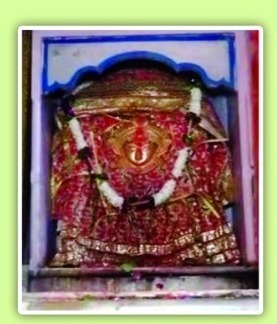KALRATRI

When the evil demon Durgasur was to be killed, Kalratri was sent by Goddess as her special emissary. Kalratri created havoc by her exhalation which resulted in huge fire balls destroying the demon’s army. (Details given under Durga Devi).
After slaying the demon and taking the form of Durga Devi, Kashi Khand states that Durga Devi guards Kashi in form of various Shaktis/Devis at various places in Kashi. Kalratri is one of them.
Maa Durga’s seventh form is Kalratri. Her body is pitch black just like darkness. Her hair is in disorder. She has garland around her neck which shines like lightning. She has 3 eyes which are round like the universe and give out lightning rays continuously. She exhales fire flames continuously through her nose. Her vehicle is a donkey. Her upper right hand grants blessings and lower right hand assures protection. Her upper left hand has an iron thorn and her lower left hand has a dagger.
Though her appearance is fearsome, she always grants auspicious boons. So her name is Shubhkari. Her devotees need not fear her. She destroys evil, so demons and ghosts run away even when somebody thinks about her. Her devotees are freed from fear (phobia) of fire, water, animals, enemies, night etc i.e. all kinds of fear.
Kalratri devi is considered to be very powerful.
Please watch our YouTube Video about Kalratri Devi at following Link
https://www.youtube.com/watch?v=HY-Z3pvPaBU&t=97s
LOCATION OF KALRATRI
Kalratri is located at D.8/17, Kalika Galli, which is a lane parallel to Annapurna – Vishwanath Lane. People can travel to Dasaswamedh by rickshaw and walk through the Gully to Visweshwar temple and after crossing Sakshi Vinayak, they may take right turn, climb a few steps and reach Kalika Galli through Shukreshwar.
Devotees worship Kalratri Devi during Navratri falling in September/October and some people refer regard this Goddess as a form of Kali. The road Kalika Galli is named after this Goddess. This temple is one of the Shakti Peets of Varanasi.
TYPES OF POOJA
The temple is open from 06.00 a.m. to 12.30 p.m. and from 04.00 p.m. to 10.30 p.m. Aarties are held in the morning and evening.
According to old timers, Kalratri is a very powerful Devi and at any time, few old people can be seen in the temple premises deeply engrossed in prayers.
JYESHTA GAURI
The importance of Jyeshta Gauri has been described amply in Kashi Khand, Chapter 63. Lord Shiva said, in the Jyeshta Month (May 20 to June 20), eighth day after Amavasya (Shukla Paksha Ashtami), people should have darshan of Jyeshta Gauri.
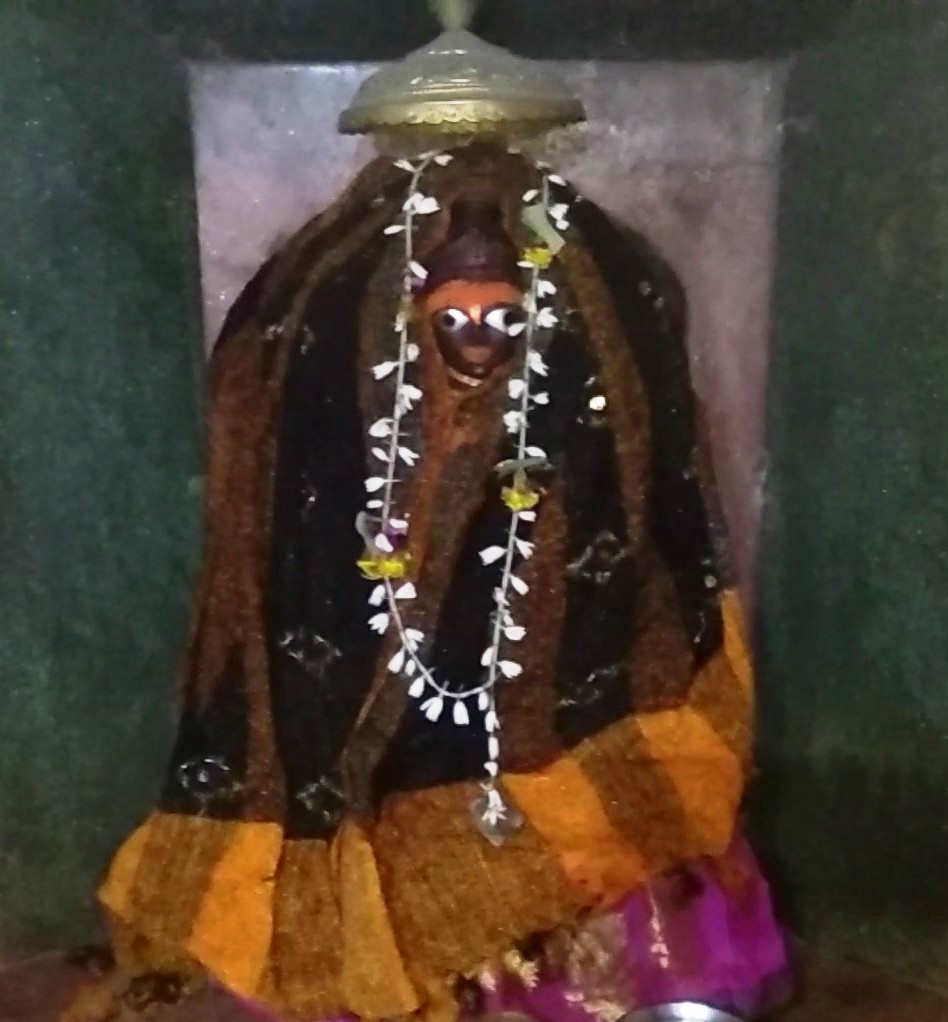
(JYESHTA GAURI)
If a girl, who may be most unfortunate, visits the Jyeshta Gauri Temple and prays with sincerity, she becomes most fortunate (Sowbhagyavati). It is stated that persons visiting Kashi and having darshan of Jyeshta Gauri will reach a high position in life (Kashi Khand, ibid).
Jyeshta Gauri temple is one of the Nine Gauri temples, which are worshipped in Vasantha Nav Ratri (9 days preceding Rama Navami day).
——————————————————————————————————-
Kashi Khand, Chapter 63, Shlok 20
जयेष्ठेश्वरोऽर्च्य: प्रथमं काश्यां श्रेयोऽर्थिभिर्नरै:
ज्येष्ठा गौरी ततोऽभ्यर्च्या सर्वज्येष्ठमभीप्सुभि:
People who want welfare, should first of all worship Jyeshtheshwar in Kashi, and then by worshiping Jyeshtha Gauri, they will get the position of seniority among all.
———————————————————————————————————
LOCATION OF THE TEMPLE
Jyeshta Gauri temple is located at K-63/24, Sapt Sagar Mohalla. The temple is approachable from a famous locality called Maidagin. People can approach Maidagin by Auto or Cycle Rickshaw or even car. From Maidagin it is advisable to walk on foot. A famous landmark near this temple is the Kashi Devi Temple.
Please watch our YouTube Video about Jyeshta Gauri at following Link
https://www.youtube.com/watch?v=fCdOgKOyD0s
TYPES OF POOJAS
The temple is open for worship practically throughout the day. Aarties are held in the morning and evening. According to old timers, special importance to this temple is attached only on Navratri Gauri Yatras and some special occasions.
It was also given to understand that pious ladies staying near the temple area gather once in while to sing religious songs and bhajans which creates a spiritual atmosphere.
HAYAKANTI DEVI
According to Kashi Khand, Chapter 70, near Mahalakshmi Devi a Devi by name of Hayakanti is present with a sickle in her hand.
Hayakanti Devi destroys the obstacles coming in the way of devotees just as the plants and trees are felled with a sickle.
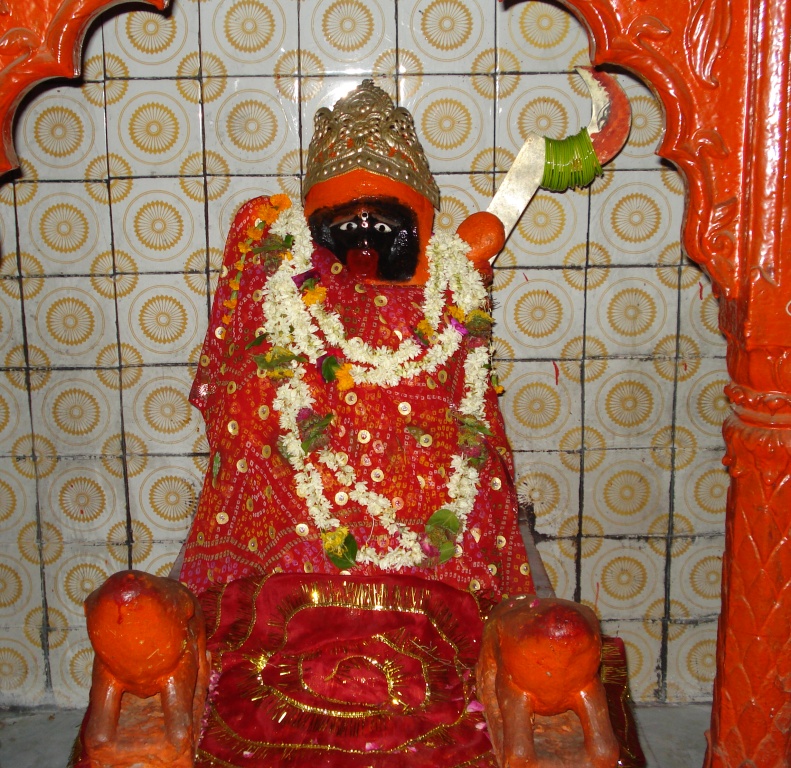
(HAYAKANTI DEVI)
A person who worships Hayakanti Devi with all sincerity will see all the obstacles in his smooth life disappear.
The part “Kant” in Hayakanti is pronounced as “Kant” in Neelkant.
LOCATION OF HAYAKANTI DEVI
Hayakanti Devi is located at D.52/35, Kali Mutt, Lakshmi Kund. People can reach this place by rickshaw through Luxa. Lakshmi Kund is a famous locality.
Please watch our YouTube Video about Hayakanti Devi at following Link
https://www.youtube.com/watch?v=BQZWSYUQx5k&t=53s
TYPES OF POOJA
The place of worship is open from 05.00 a.m. to 11.30 a.m. and from 05.30 p.m. to 10.00 p.m. Aarties are held in the morning and evening. The timings may be flexible.
DURGA DEVI (KOOSHAMANDA DURGA)
Sage Agasthya wanted to know from Lord Kartikeya as to how Goddess got the name of Durga (Kashi Khand, Chapter 71).
Lord Kartikeya narrated, once there was a Demon named Durgasur who underwent intense prayers for several long years and achieved the powers whereby no man could defeat him. Due to this and on account of his sheer arrogance he began tormenting all religious people, he got several worlds (Bhoo Lok, Swarg Lok etc.) under his control.
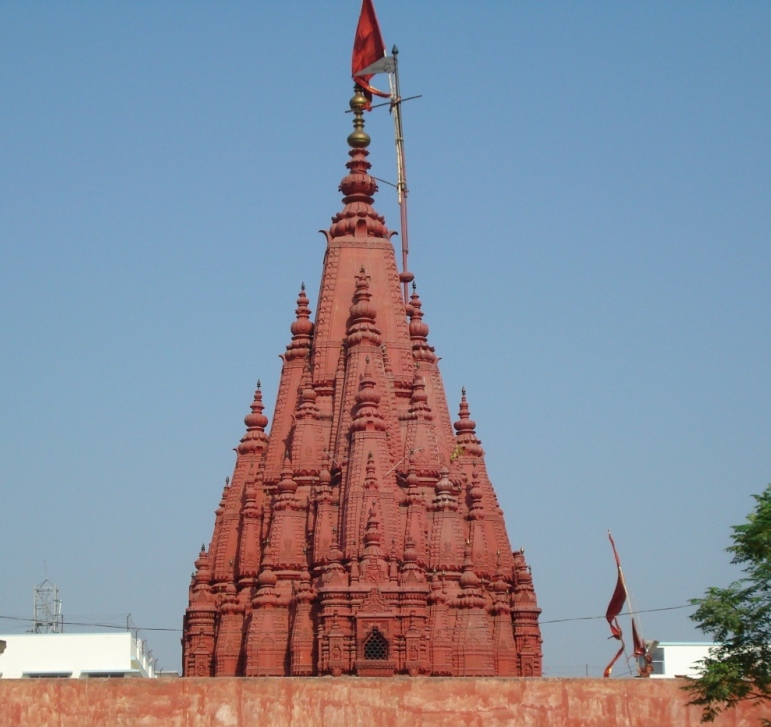
(DURGA TEMPLE)
He destroyed various Gurukuls (residential schools), Yagya Shala (places where Yagya/fire rituals were performed), imprisoned various religious Heads, imprisoned various Rishi Patnis (wives of sages). Rivers started flowing in wrong direction, crops started giving different kinds of yields.
All the devas and human beings approached Lord Shiva and sought refuge. Lord Shiva knew about the powers of Durgasura especially that the latter could not be killed by a Man. He hinted the Devi to do the needful.
Devi sent her emissary, Kalratri, alongwith a few other ladies to warn Durgasur. Kalratri reached Durgasur’s abode and passed on the message. She further asked him to refrain from tormenting religious people, return the land etc. grabbed by him and go elsewhere, otherwise Goddess Devi would certainly slay him. With utter arrogance Durgasur asked his warriors to capture Kalratri and imprison her.
When the warriors approached her, Kalratri exhaled with a roar which produced jets of fire balls and thousands of the warriors were killed. This further infuriated Durgasur, who ordered more warriors to chase her. Kalratri immediately flew through the sky, reached Goddess’s abode near Vindhyachal mountains and reported the entire happenings to Goddess.
Soon Durgasur arrived at the place where Goddess was stationed and a fierce war ensued. In the process, Devi released all her Shaktis which took form of various female warriors (with extreme powers).
The battle has been described in detail in Kashi Khand. Here we may suffice it to say that Goddess, with her extreme powers, killed Durgasur and all his deputies. There was extreme joy in the entire world and peace and happiness returned.
All devas and other learned people praised Goddess by reciting Vajra Panchakam. Goddess was pleased and assumed the name of Durga Devi (on account of slaying Durgasur). Goddess Durga told the people that devotees should recite Vajra Panchakam which will help them in overcoming any sort of obstacles.
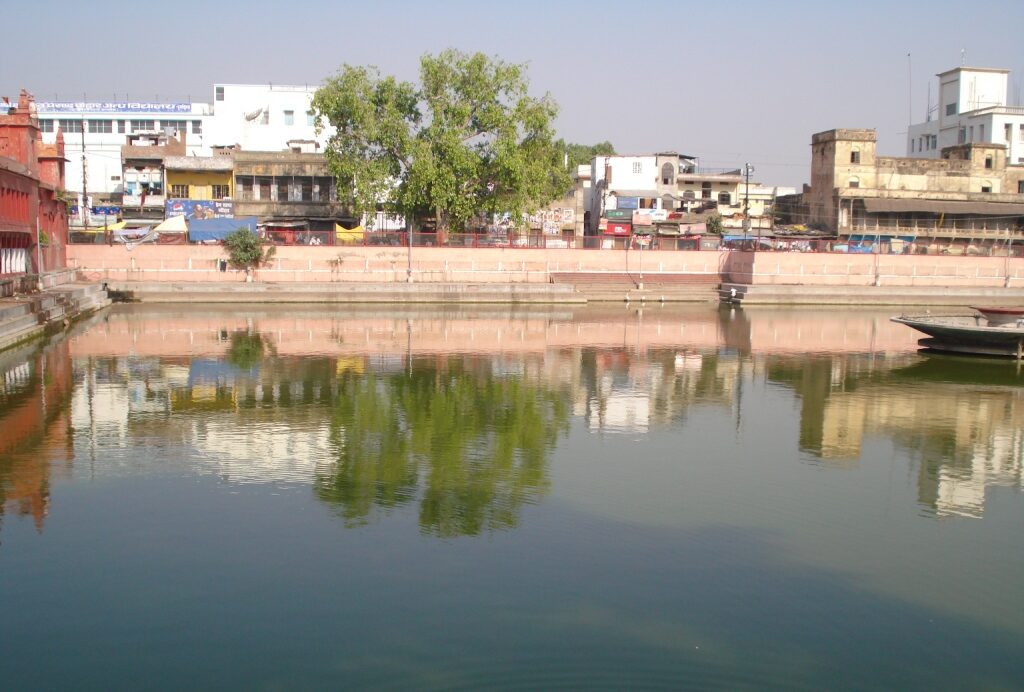
(DURGA KUND)
On Asthami and Chaturdasi, especially if Tuesday combines with the above days, devotees should worship Durga Devi in Kashi. Goddess will bless devotees with purity in thoughts and deeds. Devotees should perform various kinds of poojas to please Durga Devi. In Sharad Navaratri and Vasanth Navaratri, devotees should undertake Yatra of Durga Devi.
——————————————————————————————————-
Kashi Khand, Chapter 72, Shlok 82
अष्टम्यां च चतुर्दश्यां भौमवारे विशेषतः
सम्पूज्या सततं काश्यां दुर्गा दुर्गतिनाशिनी
Devotees are advised to perform pooja of Durga Devi (destroyer of distress) on Ashtami, Chaturdasi days and specially on Tuesdays.
———————————————————————————————————
During Navratri, devotees should take bath in Durga Kund and worship Durga Devi without fail. By this act, the devotee will cleanse all sins accumulated over his entire life time.
Please watch our YouTube Video about Durga (Kooshmanda) Devi at following Link
https://www.youtube.com/watch?v=7i5RVjROvbQ&t=68s
LOCATION OF DURGA DEVI
Durga Temple of Kashi is quite famous and is located at Durga Kund area. People can travel upto this place in car/auto or cycle rickshaw.
Devotees worship Durga Devi during Navratri falling in September/October and this Goddess is also referred to as Kooshamanda Devi. Though there is a practice of worshipping one Devi each starting from day one, there is a heavy rush of devotees on all days of both Navratries.
TYPES OF POOJA
The temple is open from 04.00 a.m. to 01.00 p.m. and from 03.00 p.m. to 11.00 p.m. This is one of the well maintained temples with idols of Goddesses Lakshmi, Saraswati and Kali present in the premises. Frequently, Chandi Havan is conducted in the temple.
Kashi Khand mentions that devotees should offer Bali (slaying of animals). Old timers say that till several decades back Bali was being offered and there is a place earmarked for that purpose near the temple. But nowadays Bali is banned by the Government.
POOJARIES OF THE TEMPLE
Shri Vijay Dubey is one of the priests of the temple and he can be contacted in his Cell No. (0)9453365725 for performing any special Pooja, Chandi Havan etc.
CHITRA GHANTA DEVI
Kashi Khand advises devotees to take bath in Chitra Koop, worship Chitra Gupteshwar and perform pooja of Chitra Ghanta Devi.
By performing poojas with all divinity, the devotee’s name will not figure in the books of Chitra Gupta. It is noteworthy to mention here that Chitra Gupta records the sins committed by various devotees, who ultimately find their way to Hell. Kashi Khand is very succinct in its narration.
By saying that the devotee’s name will not figure in the books of Chitra Gupta, it means that all the sins of the devotee, committed knowingly or unknowingly will be cleansed away.
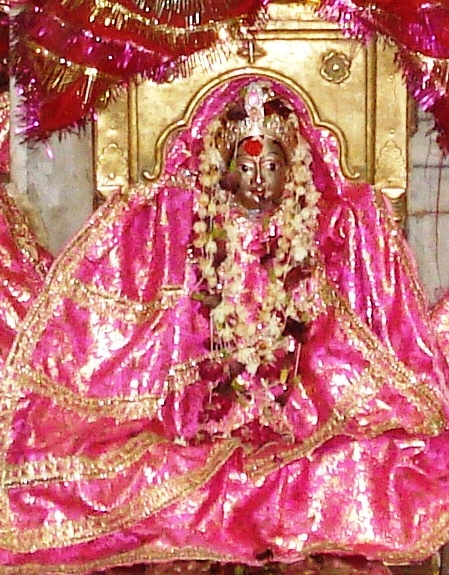
(CHITRA GHANTA DEVI)
As per Puranic belief, the third power of Maa Durga is Chitra Ghanta who is worshipped on the third day of Navratri. She has a crescent shaped bell on her forehead and so she is called Chandra Ghanta. Her body has a golden glow. She has ten hands which have different weapons. Her vehicle is lion and her posture signifies readiness for battle.
In spite of her warrior attitude, she presents a mild, prosperous and peaceful form to her devotees. Since she is always ready for battle, she gives blessings to her devotees very fast. Her devotees are as mighty and brave as a lion and at the same time they exude a peaceful and happy radiance wherever they go.
Maa Chitra Ghanta relieves her devotees of all difficulties and they get success very easily.
Please watch our YouTube Video about Chitra Ghanta Devi at following Link
https://www.youtube.com/watch?v=4J2GrPNCmlc&t=32s
LOCATION OF CHITRA GHANTA DEVI
Chitra Ghanta Devi is located at Ck. 23/34, Chitra Ghanta Gulli. Devotees can travel upto Chowk by rickshaw and walk on foot to this place. The temple is situated in a narrow gully somewhat opposite UCO Bank in Chowk. Devotees specially worship this Devi on the Navaratri falling in September/October.
TYPES OF POOJA
The temple remains open in the morning from 06.00 a.m. to 10.00 a.m. and from 6.00 p.m. to 08.00 p.m. However, devotees can have darshan practically the whole day, through the grill gate. According to locals, the timings are flexible.
CHARMA MUNDA DEVI
According to Kashi Khand, Chapter 70, in Tarkeshwar Teerth, devotees can find Charma Munda Devi. The Devi is visualised as a huge figure trying to swallow the entire galaxy. She is described holding skull and knife in her hand with thousand shoulders. Her hands are very huge.
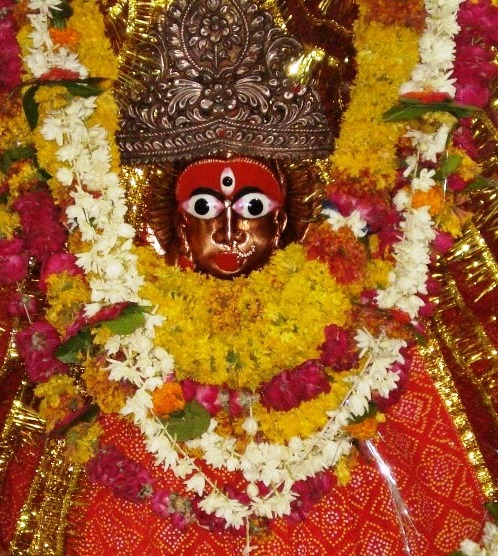
(CHARMA MUNDA DEVI)
She destroys all the evil forces and the enemies of the Holy place are chewed by her in her mouth. Devotees who worship Charma Munda Devi will not face any obstacles in their religious life.
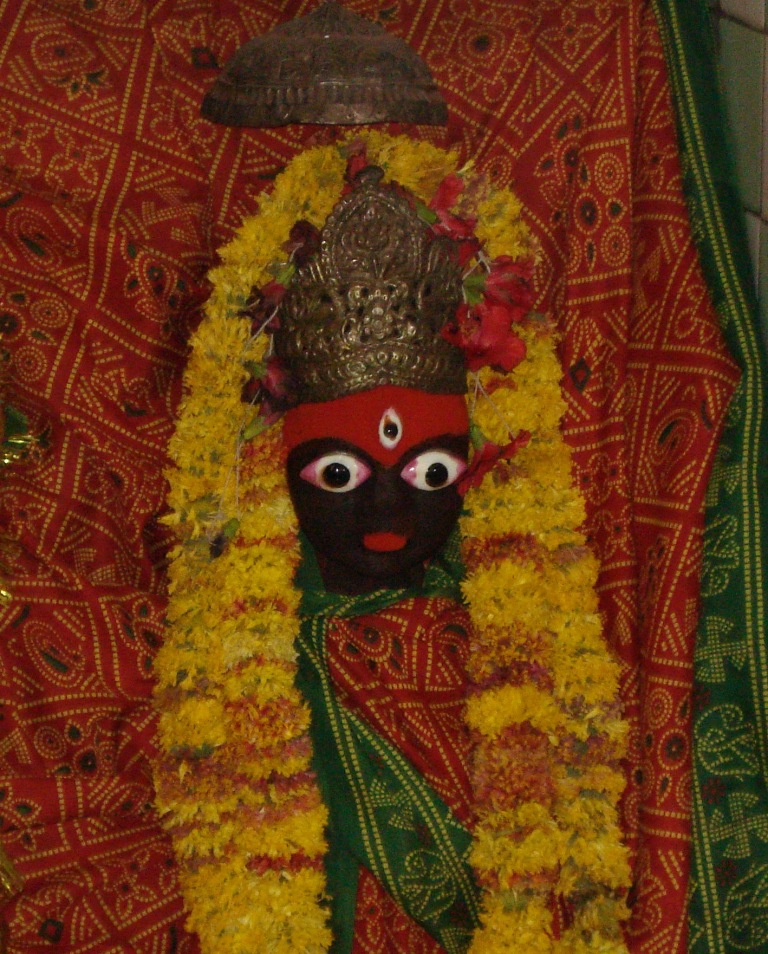
(MAHA MUNDA DEVI)
LOCATION OF CHARMA MUNDA DEVI
Charma Munda Devi is located at B-2/62 Bhadaini. If one proceeds after Mata Anandmayee Hospital towards Assi, there is left turn going towards Bhadaini Water Works. The corner building is B-2/61 which is the house of the Priest of the temple. There is a fairly steep slope over which this temple is situated. The locals call this temple as Nav Durga Temple.
The temple also houses Maha Munda Devi (Maha Runda) which has reference in Kashi Khand, Chapter 70.
TYPES OF POOJA
The place of worship is open from 05.30 a.m. to 10.00 a.m. and from 04.00 p.m. to 10.00 p.m. Mangala Aarti is performed at 05.45 a.m., Bhog Aarti at 10.00 a.m., evening aarti at 07.30 p.m. and Shayan Aarti at 10.00 p.m.
CHANDI DEVI
Kashi Khand, Chapter 83 mentions seven Matrika Devis and Chandika Devi is the last among them. They were instrumental in giving life to a young boy. Details mentioned under Veereshwar.
These Matrika Devis are extremely powerful and are capable of giving Siddhis to their Devotees.
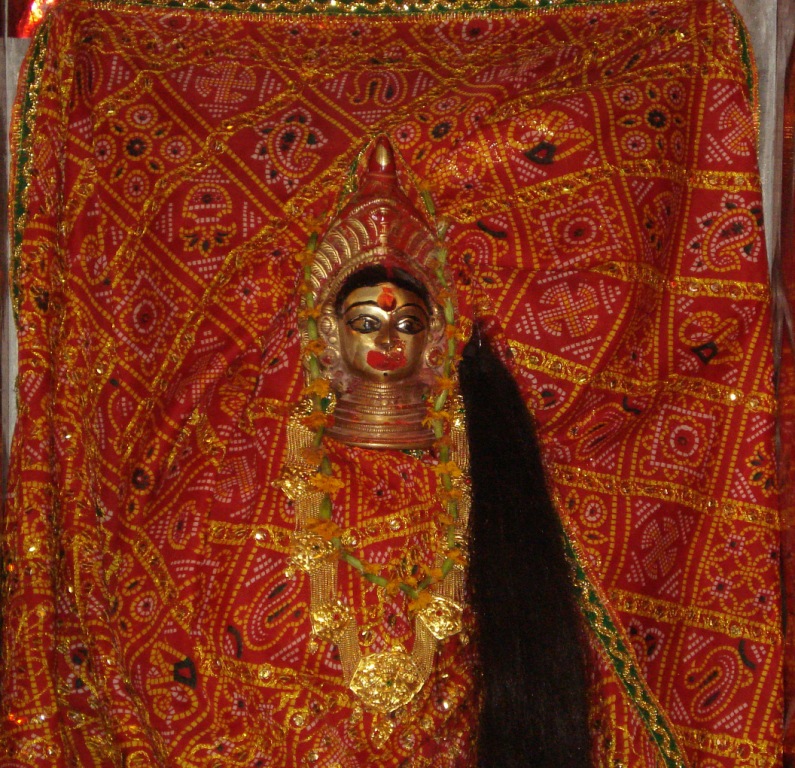
(CHANDI DEVI)
Further Kashi Khand, Chapter 70 mentions various powerful Devis located at several places in the Holy city of Kashi and Kaurmi Shakti is one of them. Shri Kedar Nath Vyas in his book published after extensive research has given Chandi Devi as the name of this powerful deity.
One point may be mentioned here. The deities mentioned in Kashi Khand may not be in the same place as mentioned therein. They could have been relocated to other places for various reasons like foreign invasion etc. Further, some of the deities, Shiv Lings are no longer existing.
Regular poojas are being done in this temple. During Chaitra Navaratri (March/April) and Sharadeya Navaratri (Sept/Oct), special poojas and Aarti are done. The saptami Aarti is a real treat to watch and there is a huge crowd. For this Aarti, the Chief Priest assumes the form of Kali Devi.
LOCATION OF CHANDI DEVI
Chandi Devi is located at Sadar Bazar. In the Cantonment area, if a devotee proceeds in the road where various posh hotels are located, he will come across Radisson, Ideal Towers, Hotel Clarks etc. and JHV Mall. If he proceeds further in the road (known as Cariappa Marg), he will come across a turning to the right where there is an indicator reading “Bheeshma Chandi Devi temple”.
Please watch our YouTube Video about Chandi Devi at following Link
https://www.youtube.com/watch?v=BQZWSYUQx5k&t=53s
TYPES OF POOJA
This place of worship is open from 05.00 a.m. to 10.00 p.m. and devotees can worship as per their convenience. According to locals this temple is a powerful Shakti Peeth.
CHAMUNDA DEVI
In Hayagreeva Teerth and to the north of Lolark, devotees will find Chamunda Devi. Chamunda Devi alongwith Charma Munda Devi and Maha Munda Devi are regarded as Kshetra Rakshikas (guardians of Region).
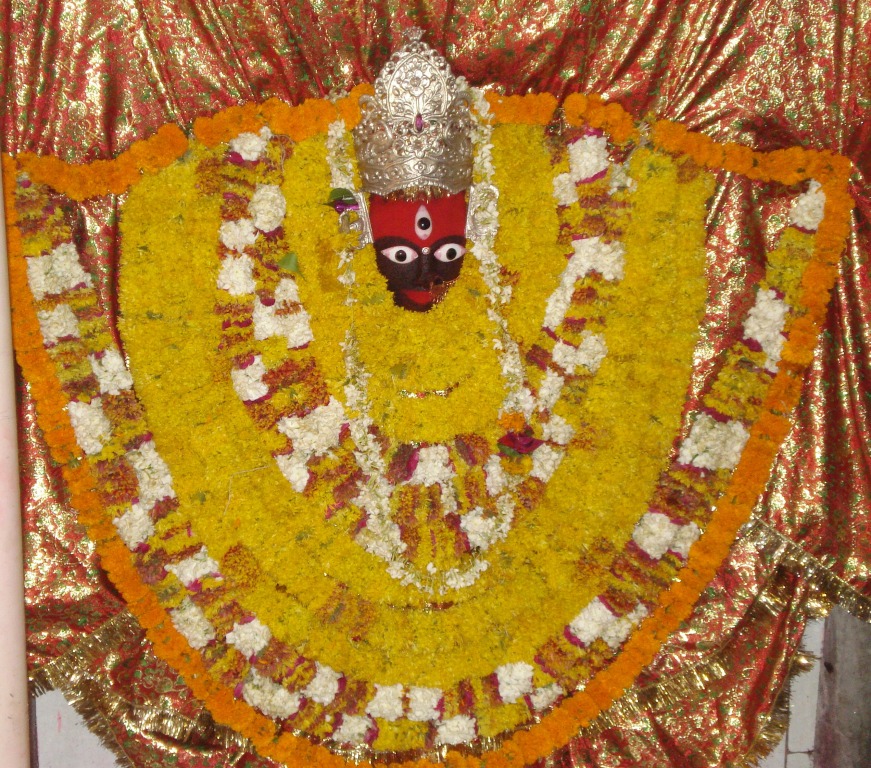
(CHAMUNDA DEVI)
LOCATION OF CHAMUNDA DEVI
This Devi is known by the name of Mahishasura Mardini near Lolark Kund, which is quite famous. People can travel upto this place in rickshaw as this temple is well known.
TYPE OF POOJA
The temple is open from 05.30 a.m. to 11.30 a.m. and from 05.00 p.m. to 09.00 p.m. Aarties are held in the morning and evening. Evening aarti at around 07.00 – 07.30 is worth watching.
BRAHMA CHARINI DEVI
According to Kashi Khand, Chapter 70, in the vicinity of Brahmeshwar, devotees can find Brahma Devi (Brahmacharini).
Among the nine forms of Maa Durga, Brahmacharini is the second. Here Brahma means Tapasya (penance). Brahmacharini means one who observes penance. Brahmacharini Devi’s form is brilliant and very magnificent. She has a bead garland in her right hand and a Kamandalu (water pot) in her left hand.
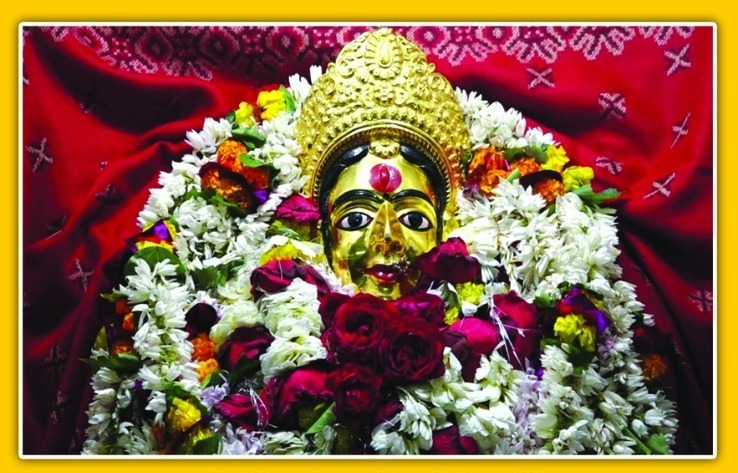
(BRAHMACHARINI DEVI)
In her previous birth she was born as the daughter of Himalaya. At that time, she was encouraged by Sage Narad’s advice and she underwent a rigorous penance for several thousand years to be blessed with Lord Shiva as her husband. Due to this rigorous penance, she was called Tapascharini. All the Devas and Sages described her penance as extra ordinary and began to praise her. In the end, Lord Brahma was also impressed and addressed her saying that nobody had done such a rigorous penance and it has been admired by everybody everywhere. Lord Brahma further stated that Tapascharini will get Lord Shiva as her husband.
This second form of Maa Durga grants her devotees unlimited wishes. By worshipping her the qualities like penance, sacrifice, freedom from wordly desires, discipline, self control etc. increase in a devotee. Even in adverse circumstances his mind does not waver from his duties. Due to her blessings he attains victory and prosperity everywhere.
The Devi is described as paralyzing the enemies by sprinkling the holy water from the water jug. Those who worship this Devi daily will become adept in Brahma Vidya. In the modern day parlance, this can be taken for higher education.
Please watch our YouTube Video about Brahmacharini Devi at following Link
https://www.youtube.com/watch?v=4J2GrPNCmlc&t=32s
LOCATION OF BRAHMA CHARINI DEVI
Brahma Charini is located at K-22/72, Durga Ghat. Devotees can travel upto Bhaironath by rickshaw and walk on foot upto Brahmeshwar temple. Alternatively, they can travel upto Durga Ghat / Brahma Ghat by boat and climb the steps. Devotees specially worship Brahmacharini Devi during Navratri falling in September/October. There is another Devi worshipped as Brahmini who is very powerful alongwith Goddesses like Maaheshwari, Varahi etc. This Devi idol is located at Brahmeshwar temple at D-33/66 Khalispura, near Dasaswamedh, Varanasi.
TYPES OF POOJA
The temple is open from 06.00 a.m. to 01.30 p.m. and from 04.00 p.m. to 11.00 p.m. Aarti is performed at 06.00 a.m., 04.00 p.m. and 11.00 p.m. (Shayan Aarti).
POOJARI OF THE TEMPLE
Shri Rajesh Sagarkar is the Poojari of the temple and he can be contacted at his phone No. 0542-2437004 for performing any special pooja etc.
BHAVANI GAURI
Kashi Khand, Chapter 100 has prescribed Gauri Yatra (religious tour of Gauri temples). This Yatra is to be undertaken on Triteeya after Amavasya (3rd day after Amavasya).
Devotees should take bath in Bhavani Teerth and worship Bhavani Gauri. Devotees who worship Bhavani Gauri will get all sorts of happiness and prosperity in life.
(BHAVANI GAURI)
LOCATION OF BHAVANI GAURI
Bhavani Gauri is located at D.8/38, Ram Mandir annexed to the premises of Annapurna Devi. The deity is located between Kali Devi and Jagannath. Regarding directions to reach this place, kindly refer to Visweshwar temple.
Devotees visit this place of worship on the seventh day of Chaitra Navaratri in March-April.
Please watch our YouTube Video about Bhavani Gauri at following Link
https://www.youtube.com/watch?v=3vw_Rptu-BE&t=61s
TYPES OF POOJA
This place of worship remains open from 05.30 a.m. to 11.30 a.m. and from 05.00 p.m. to 09.30 p.m. Timings are flexible.
